Related Research Articles

Pilosella aurantiaca is a perennial flowering plant in the family Asteraceae that is native to alpine regions of central and southern Europe, where it is protected in several regions.

Hieracium , known by the common name hawkweed and classically as hierakion, is a genus of flowering plant in the family Asteraceae, and closely related to dandelion (Taraxacum), chicory (Cichorium), prickly lettuce (Lactuca) and sow thistle (Sonchus), which are part of the tribe Cichorieae. Hawkweeds, with their 10,000+ recorded species and subspecies, do their part to make Asteraceae the second largest family of flowering plants. Some botanists group all these species or subspecies into approximately 800 accepted species, while others prefer to accept several thousand species. Since most hawkweeds reproduce exclusively asexually by means of seeds that are genetically identical to their mother plant, clones or populations that consist of genetically identical plants are formed and some botanists prefer to accept these clones as good species whereas others try to group them into a few hundred more broadly defined species. What is here treated as the single genus Hieracium is now treated by most European experts as two different genera, Hieracium and Pilosella, with species such as Hieracium pilosella, Hieracium floribundum and Hieracium aurantiacum referred to the latter genus. Many members of the genus Pilosella reproduce both by stolons and by seeds, whereas true Hieracium species reproduce only by seeds. In Pilosella, many individual plants are capable of forming both normal sexual and asexual (apomictic) seeds, whereas individual plants of Hieracium only produce one kind of seeds. Another difference is that all species of Pilosella have leaves with smooth (entire) margins whereas most species of Hieracium have distinctly dentate to deeply cut or divided leaves.
A dry roadside dotted with small, ¾ inch red orange flowers, interspersed with very similar yellow ones, and often the white of daisies, is a good sign that you are in Hawkweed country.
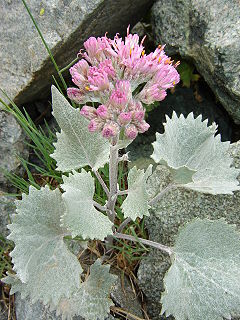
Adenostyles is a genus of flowering plants in the sunflower family Asteraceae, and of the tribe Senecioneae. It was described as a genus in 1816. Adenostyles occur in the temperate climates of the northern hemisphere, mainly in Europe and Asia Minor.

Pilosella officinarum, known as mouse-ear hawkweed, is a yellow-flowered species of flowering plant in the daisy family Asteraceae, native to Europe and northern Asia. It produces single, lemon-coloured inflorescences. Like most hawkweed species, it is highly variable and is a member of a species complex of several dozens of subspecies and hundreds of varieties and forms. It is an allelopathic plant.

Hieracium umbellatum, the Canadian hawkweed, Canada hawkweed, narrowleaf hawkweed, or northern hawkweed, is a flowering plant in the family Asteraceae.
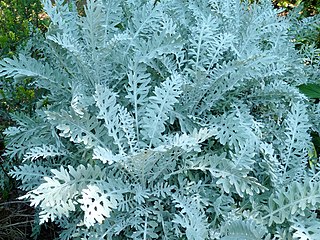
Centaurea cineraria, the velvet centaurea, is – like some other plants – also known as dusty miller and silver dust. It is a small plant in the family Asteraceae and originates from the Island of Capraia in Italy, where it is called fiordaliso delle scogliere.

Baptisia tinctoria is a herbaceous perennial plant in the family Fabaceae. It is native to eastern North America.

Hieracium hieronymi is a forb of genus Hieracium in the family Asteraceae. and found only in Ecuador once in a collection gathered in 1871 from Pichincha; the description included with the specimen was "Crescit prope Panecillo haud procul a praedio Hacienda Pesillo inter urben Quito et La Esperanza", and in a more recent specimen reported by L. Mille still some years ago gathered from Carchi and deposited in the Berlin Herbarium where the taxonomic problems have remained intact.

Hieracium lachenalii, also known as common hawkweed or yellow hawkweed, is a species of plant in the tribe Cichorieae within the family Asteraceae. It is native to Europe but has become established as a weed in Australia and parts of North America. The species was widely known for many years as H. vulgatum, but more recent studies have indicated that the two names represent the same species. The name H. lachenalii was coined in 1802, H. vulgatum in 1819, so the older name is to be used.

Pilosella caespitosa is like several other Pilosella species and has a similar appearance to many of the hawkweeds.
Hieracium rigorosum, a name for a plant in the hawkweed genus Hieracium, has been identified as synonyms of two different species:
Hieracium stiptocaule, a name for a plant in the hawkweed genus Hieracium, is a synonym of two different species:
Hieracium devoldii, a name for a plant in the hawkweed genus Hieracium, has been identified as a synonym of two different species:
Hieracium musartutense, a name for a plant in the hawkweed genus Hieracium, has been identified a synonym of two different species:
Hieracium nepiocratum, a name for a plant in the hawkweed genus Hieracium, has been identified a synonym of two different species:
Hieracium eugenii, a name for a plant in the hawkweed genus Hieracium, has been identified as a synonym of two different species:
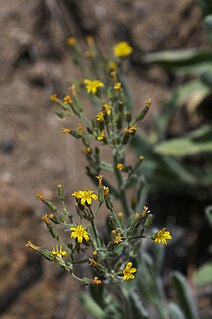
Hieracium horridum, known as the prickly hawkweed or shaggy hawkweed, is a species of plant in the family Asteraceae. It gets its name from the long, dense, shaggy white to brown hairs (trichomes) which cover all of the plant parts of this plant species. The species is native to Oregon, California, and Nevada in the western United States.
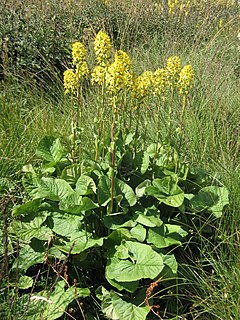
Ligularia sibirica is the type species for the genus Ligularia. It is a 0.3-1.3 m tall perennial herbaceous plant, native to fens and damp grassy meadows in Siberia, Central and Eastern Europe. Once fairly common, it has disappeared from many places in Europe, owing to drainage of wetlands and competition from other plants invading its natural habitats; when growing in shade plants do not flower or set seed very well and seed germination is greatly reduced. This species is sometimes grown in gardens for its large leaves and tall spike like arrangement of yellow daisy like flowers.
Pilosella floribunda is a species of noxious and herbaceous perennial plant from family Asteraceae that is known in Europe and can also be found in United States and Canada. It was believed that it was a hybrid of Pilosella caespitosa (Hieracium caespitosum and Pilosella lactucella.
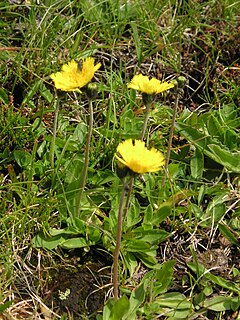
Pilosella lactucella is a species of perennial plant from the family Asteraceae, found in Europe, New York and Nova Scotia (Canada). It is 9–20 centimetres (3.5–7.9 in) in height, with stems from 1–2 millimetres (0.039–0.079 in) wide. The leaves are spatula shaped and 5–8 centimetres (2.0–3.1 in) wide. The flowers bloom from May to July, the heads of which are 2–5 centimetres (0.79–1.97 in) tall. It was once described by Carl Linnaeus as Hieracium auricula and Pilosella auricula, but was recategorized by A. E. Roland and M. Zinck in 1998.
References
- ↑ International Organization for Plant Information (IOPI). "Plant Name Search Results". International Plant Names Index. Retrieved 2007-12-17.
- ↑ International Organization for Plant Information (IOPI). "Details for: Hieracium". Provisional Global Plant Checklist. Archived from the original on 2013-12-13. Retrieved 2007-12-17.
- 1 2 Natural Resources Conservation Service (2007). "PLANTS Profile for Hieracium laevigatum (smooth hawkweed)". The PLANTS Database. USDA, Baton Rouge, LA 70874-4490 USA. Retrieved 2007-12-23.
- ↑ Integrated Taxonomic Information System (ITIS). "Standard Report acranthophorum Om" . Retrieved 2007-12-23.
- 1 2 3 4 5 6 7 8 9 10 11 12 13 14 15 16 17 18 19 20 21 22 23 24 25 26 27 28 29 30 31 32 33 34 35 36 Botanic Garden and Botanical Museum Berlin-Dahlem (June 5, 2007). "Details for: Pilosella piloselloides". The Euro+Med Plantbase. Botanic Garden and Botanical Museum Berlin-Dahlem. Retrieved 2007-12-21.
- 1 2 3 4 5 6 7 8 Royal Botanic Garden Edinburgh. "Flora Europaea Hieracium caespitosum" . Retrieved 2007-12-15.
- ↑ "Hieracium amplexicaule". Alpine Flowers / Mountain Flowers. Retrieved 2007-12-14.
- ↑ "Hieracium amplexicaule, Accessed through GBIF Data Portal". Biodiversity occurrence data provided by: Botanic Garden and Botanical Museum Berlin-Dahlem. Retrieved 2007-12-15.
- 1 2 3 4 5 Botanic Garden and Botanical Museum Berlin-Dahlem. "Details for: Pilosella floribunda". The Euro+Med Plantbase. Botanic Garden and Botanical Museum Berlin-Dahlem. Retrieved 2007-12-14.
- 1 2 3 4 5 University of Birmingham. "PGR Forum CWR Catalogue for Europe and the Mediterranean Hieracium polymastix". CWRIS PGR Forum Crop Wild Relative Information System. Retrieved 2007-12-24.
- ↑ Natural Resources Conservation Service (2007). "PLANTS Profile for Hieracium Hieracium lachenalii Common hawkweed". The PLANTS Database. USDA, Baton Rouge, LA 70874-4490 USA. Retrieved 2007-12-15.
- ↑ The International Plant Names Index (August 21, 2007). "Details for: Hieracium caespitosum". Provisional Global Plant Checklist. International Organization for Plant Information (IOPI). Retrieved 2007-12-15.
- 1 2 3 4 Botanic Garden and Botanical Museum Berlin-Dahlem (June 5, 2007). "Details for: Hieracium lachenalii". The Euro+Med Plantbase. Botanic Garden and Botanical Museum Berlin-Dahlem. Retrieved 2007-12-14.[ permanent dead link ]
- ↑ Botanic Garden and Botanical Museum Berlin-Dahlem (June 5, 2007). "Details for: Pilosella caespitosa". The Euro+Med Plantbase. Botanic Garden and Botanical Museum Berlin-Dahlem. Retrieved 2007-12-21.
- 1 2 3 Natural Resources Conservation Service (2007). "PLANTS Profile for Hieracium canadense Michx". The PLANTS Database. USDA, Baton Rouge, LA 70874-4490 USA. Retrieved 2007-12-18.
- 1 2 Natural Resources Conservation Service (2007). "PLANTS Profile for Hieracium scouleri Hook. var. albertinum". The PLANTS Database. USDA, Baton Rouge, LA 70874-4490 USA. Retrieved 2007-12-18.
- 1 2 Botanic Garden and Botanical Museum Berlin-Dahlem (June 5, 2007). "Details for: Hieracium caespitosum". The Euro+Med Plantbase. Botanic Garden and Botanical Museum Berlin-Dahlem. Archived from the original on July 3, 2013. Retrieved 2007-12-15.
- 1 2 3 4 5 Botanic Garden and Botanical Museum Berlin-Dahlem (June 5, 2007). "Details for: Hieracium umbellatum". The Euro+Med Plantbase. Botanic Garden and Botanical Museum Berlin-Dahlem. Retrieved 2007-12-21.
- ↑ "Hieracium hypochoeroides S.Gibson". Plants of the World Online. Board of Trustees of the Royal Botanic Gardens, Kew. Retrieved 23 May 2021.
- ↑ Royal Botanic Garden Edinburgh. "Flora Europaea Hieracium umbellatum" . Retrieved 2007-12-15.
- ↑ Botanic Garden and Botanical Museum Berlin-Dahlem (June 5, 2007). "Details for: Hieracium longiscapum". The Euro+Med Plantbase. Botanic Garden and Botanical Museum Berlin-Dahlem. Retrieved 2007-12-23.
- ↑ Botanic Garden and Botanical Museum Berlin-Dahlem (June 5, 2007). "Details for: Hieracium levieri". The Euro+Med Plantbase. Botanic Garden and Botanical Museum Berlin-Dahlem. Retrieved 2007-12-23.
- 1 2 Botanic Garden and Botanical Museum Berlin-Dahlem. "Details for: Pilosella levieri". The Euro+Med Plantbase. Botanic Garden and Botanical Museum Berlin-Dahlem. Retrieved 2007-12-23.
- ↑ Gianguzzi, L.; La Mantia, A. (2006). "Hieracium lucidum". IUCN Red List of Threatened Species . 2006: e.T61624A12525812. doi: 10.2305/IUCN.UK.2006.RLTS.T61624A12525812.en . Retrieved 13 November 2021.
- ↑ The International Plant Names Index. "Search whole name = Hieracium perpropinquum" . Retrieved 2007-12-18.
- ↑ "Taxon profile species Hieracium longiscapum". International encyclopedia of plants, fungi and animals. BioLib.cz. Retrieved 2007-12-24.
- ↑ Natural Resources Conservation Service (2007). "PLANTS Profile for Hieracium caespitosum (meadow hawkweed)". The PLANTS Database. USDA, Baton Rouge, LA 70874-4490 USA. Retrieved 2007-12-15.
- 1 2 Natural Resources Canada (2007-12-21). "Hieracium umbellatum L." Canada's Plant Hardiness Site. Government of Canada. Retrieved 2007-12-27.
- ↑ Natural Resources Conservation Service. "PLANTS Profile for Hieracium robinsonii (Zahn) Fernald". The PLANTS Database. USDA, Baton Rouge, LA 70874-4490 USA. Retrieved 2007-12-22.
- ↑ Montúfar, R.; Pitman, N. (2003). "Hieracium sodiroanum". IUCN Red List of Threatened Species . 2003: e.T43447A10804976. doi: 10.2305/IUCN.UK.2003.RLTS.T43447A10804976.en . Retrieved 13 November 2021.
- ↑ Natural Resources Conservation Service. "PLANTS Profile for Hieracium sabaudum L." The PLANTS Database. USDA, Baton Rouge, LA 70874-4490 USA. Retrieved 2007-12-18.
- ↑ International Plant Names Index. "International Plant Names Index Search" . Retrieved 2007-12-15.
- ↑ Natural Resources Conservation Service (2007). "PLANTS Profile for Hieracium venosum L." The PLANTS Database. USDA, Baton Rouge, LA 70874-4490 USA. Retrieved 2007-12-22.
- ↑ McCosh, D. and Rich,T.C.G. 2009.Hieracium proximum (Caithness Hawkweed) in Ireland. Ir. Nat. J.30: 54 - 55
- ↑ Hackney, P. Ed. 1992. Stewart & Corry's Flora of the North-east of Ireland. Third Edition. Institute of Irish Studies & The Queen's University of Belfast. ISBN 0 85389 446 9
- ↑ Rich, Tim C.G. et al 2013. What is the taxonomic status of Hieracium hesperium P.D.Sell, Donegal Hawkweed (Asteraceae)? Ir. Nat. J.33:3 - 7.